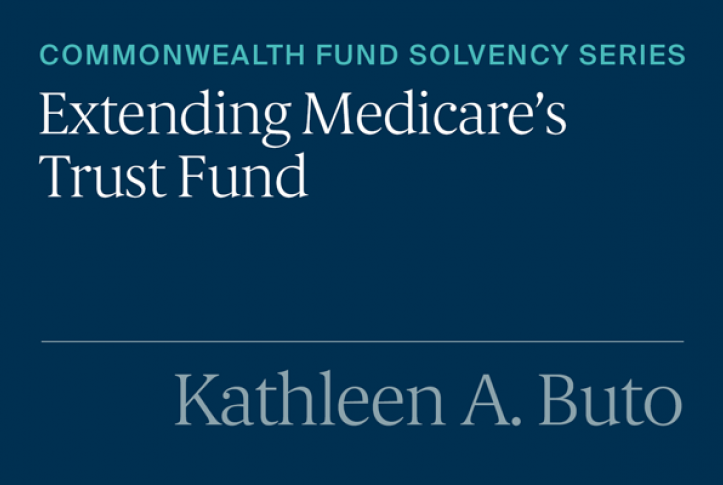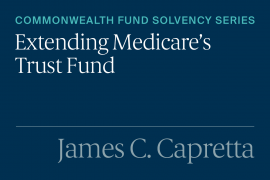The Medicare Hospital Insurance (HI) Trust Fund, which pays for Medicare beneficiaries’ hospital bills and other services, is projected to become insolvent in 2031. Without changes to expected spending or trust fund revenue, the trust fund will not have sufficient funds to cover the entire cost of beneficiaries’ health care. The HI trust fund is primarily funded through payroll taxes paid by employers and employees, with some additional income from interest as well as premiums paid by voluntary enrollees not automatically entitled to Medicare Part A. Will the trust fund solvency be extended by reducing the projected growth in expenditures, raising revenues, changes to the services covered by Medicare Part A, or a combination of these options
To stimulate policy discussions, the Commonwealth Fund asked a group of Medicare thought leaders with a variety of backgrounds and political affiliations to outline how they would extend the life of the trust fund. This series presents their perspectives, highlighting areas of commonality while also putting forth some new ideas for addressing this pressing issue.
Structural Changes Are Needed
Because long-term approaches to address solvency of the trust fund are hard to enact, Congress has sought to reform provider payments to extend solvency a few years at a time. More such changes are needed, for example to eliminate reimbursement distortions that drive utilization, reform postacute care payments, and expand payment bundles to encourage greater value. But we should redouble efforts to adopt structural changes that will fundamentally transform the program.
Premium Support
One major structural change would have the government base its contribution on a competitively set Medicare subsidy (i.e., premium support), whether beneficiaries choose a private Medicare Advantage plan or traditional fee-for-service (FFS) Medicare. With a set contribution from the federal government, beneficiaries are likely to seek higher-value, lower-cost options. While design details matter in estimating the impact, premium support would generate significant savings and extend solvency. To address concerns about long-term impact on beneficiaries’ access to care, it should include an appropriate transition, a reasonable inflation factor, and accurate risk adjustment.
Prescription Drug Spending
Prescription drug spending is one of the fastest growing drivers of Medicare costs. Flaws in Medicare’s Part D design are fueling spending on expensive drugs and high government reinsurance costs. Proposals to address these would add a catastrophic cap and shift more of the cost of reinsurance from the federal government to drug manufacturers and health plans. Such changes would realign incentives, improve plan tools, shift spending to lower-cost drugs, and reduce Medicare cost growth.
High-Need Patients
Patients with high medical needs also drive program spending, but initiatives to reduce costs for these beneficiaries have largely been unsuccessful. Efforts are needed to strengthen patients’ ability to manage their own conditions, especially for these high-need patients who drive much of Medicare spending, an approach taken by many European countries. All chronically ill beneficiaries could be assessed when they enter Medicare and periodically thereafter, using tools such as the patient activation measure to identify their needs and customize support services. The Centers for Medicare and Medicaid Services could provide patients and their primary care clinicians with web-based tools, workshops, and condition-specific guides to help patients manage medication, exercise, and nutrition and forestall more costly care. Since the needs of patients with chronic conditions change over time, self-management approaches could evolve from an emphasis on education and prevention to more active engagement with a care team and social supports.
For beneficiaries at greatest risk of incurring high costs, Medicare should consider deploying navigators to work with patients to reduce the incidence of medical complications and thereby avoid some emergency department visits and hospital stays. Navigators can be nurses, nonclinical lay staff, or others. Patient navigators have demonstrated they can work with high-cost patients following episodes of care and offer practical and emotional support and help with scheduling, interpretation, financial support, and care coordination. One study of cancer patients found that lay navigation significantly reduced costs of emergency department visits, hospitalizations, and ICU admissions. Another navigator program reduced overall postacute care costs for cardiology patients.
Challenges to introducing a patient navigator benefit include the added costs, with potential savings accruing over time; the need for early identification of the large number of patients with chronic conditions; the need to integrate navigators into care teams; an approach to certifying qualified navigators; and the need for evaluation of what works, among others.
Conclusion
Both provider payment reductions and major restructuring, like premium support and Part D reform, have key roles to play in future solvency of the Medicare Hospital Insurance Trust Fund. In addition, we must address the outsized role high-cost beneficiaries play in driving Medicare costs, by incorporating more proactive and engaged self-management and targeted patient navigators.






